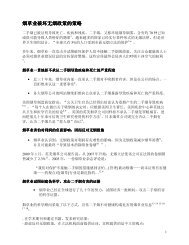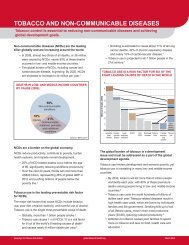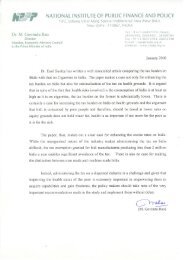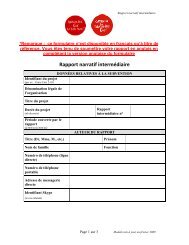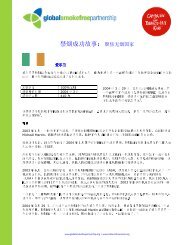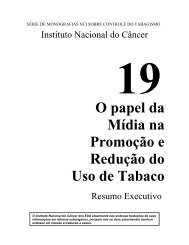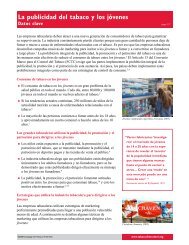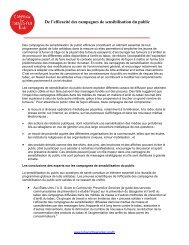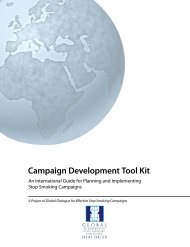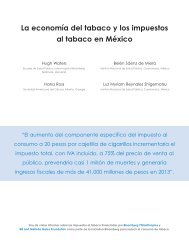Tobacco Taxes in China - Campaign for Tobacco-Free Kids
Tobacco Taxes in China - Campaign for Tobacco-Free Kids
Tobacco Taxes in China - Campaign for Tobacco-Free Kids
You also want an ePaper? Increase the reach of your titles
YUMPU automatically turns print PDFs into web optimized ePapers that Google loves.
<strong>Tobacco</strong> <strong>Taxes</strong> <strong>in</strong> Ch<strong>in</strong>a<br />
Based on <strong>Tobacco</strong> Taxation and Its Potential Impact <strong>in</strong> Ch<strong>in</strong>a<br />
by Teh-wei Hu, Zhengzhong Mao, Jian Shi, and Wendong Chen<br />
Rais<strong>in</strong>g the tobacco tax <strong>in</strong> Ch<strong>in</strong>a by 1 RMB per<br />
pack can save more than 3 million lives and<br />
generate an additional RMB 64.9 billion.<br />
The low cost of tobacco products <strong>in</strong> Ch<strong>in</strong>a contributes to very high levels of cigarette smok<strong>in</strong>g, especially among<br />
males. Ch<strong>in</strong>a’s high smok<strong>in</strong>g rate causes alarm<strong>in</strong>g health and economic costs. The most effective way to reduce tobacco<br />
use <strong>in</strong> Ch<strong>in</strong>a is to raise the price of tobacco through excise tax <strong>in</strong>creases.<br />
<strong>Tobacco</strong> Use <strong>in</strong> Ch<strong>in</strong>a 1<br />
Ch<strong>in</strong>a is the largest producer and consumer of tobacco <strong>in</strong><br />
the world.<br />
• Ch<strong>in</strong>a grows one third of the world’s tobacco crop. It<br />
produces and consumes one third (1.7 trillion) of the<br />
world’s cigarettes.<br />
• 300 million Ch<strong>in</strong>ese smoke — 36% of Ch<strong>in</strong>a’s<br />
population over age 15.<br />
• 57% of men and 3% of women over age 15 are current<br />
smokers.<br />
• Tak<strong>in</strong>g <strong>in</strong>to account both <strong>in</strong>flation and purchas<strong>in</strong>g<br />
power, cigarettes have become more than twice as<br />
af<strong>for</strong>dable <strong>in</strong> Ch<strong>in</strong>a s<strong>in</strong>ce 1990. Smok<strong>in</strong>g <strong>in</strong> Ch<strong>in</strong>a<br />
is much less costly than <strong>in</strong> Thailand, Malaysia, and<br />
S<strong>in</strong>gapore.<br />
Relative percent change <strong>in</strong> price<br />
Figure 1: Relative Change <strong>in</strong> Af<strong>for</strong>dability of<br />
Cigarettes, 1996 – 2006 2<br />
100<br />
50<br />
0<br />
-50<br />
0% (1996 basel<strong>in</strong>e)<br />
-100<br />
1996 2006<br />
91.7% Malaysia<br />
56.6%<br />
48.9%<br />
-24.2%<br />
-39.9%<br />
Thailand<br />
S<strong>in</strong>gapore<br />
Indonesia<br />
Philipp<strong>in</strong>es<br />
-64.1% Vietnam<br />
-72.5% Ch<strong>in</strong>a<br />
relatively<br />
less<br />
af<strong>for</strong>dable<br />
relatively<br />
more<br />
af<strong>for</strong>dable<br />
• The Monopoly produced 1.7 trillion cigarettes <strong>in</strong><br />
2005, generat<strong>in</strong>g tax and profit of RMB 240 billion<br />
($30 billion USD)*, equivalent to 7.6% of central<br />
government revenue. The comb<strong>in</strong>ation of tobacco<br />
tax and profit as a percentage of government revenue<br />
is decl<strong>in</strong><strong>in</strong>g over time due to rapid growth <strong>in</strong> other<br />
economic sectors.<br />
• The tobacco <strong>in</strong>dustry employs about a half million<br />
people, 0.06% of total employment <strong>in</strong> all sectors.<br />
Impact of <strong>Tobacco</strong> Use <strong>in</strong> Ch<strong>in</strong>a<br />
High smok<strong>in</strong>g rates contribute to a significant number of<br />
early deaths, high healthcare costs and lost productivity.<br />
• Ch<strong>in</strong>a has the world’s highest number of smok<strong>in</strong>gattributable<br />
deaths. One million Ch<strong>in</strong>ese die each<br />
year from tobacco-related diseases; 3 these deaths are<br />
expected to rise to 2 million by the year 2020. 4<br />
• Smok<strong>in</strong>g costs Ch<strong>in</strong>ese society RMB 186 billion<br />
($22.7 billion USD) each year, or 1.9% of Ch<strong>in</strong>a’s<br />
GDP. Direct medical costs of smok<strong>in</strong>g are RMB 14<br />
billion ($1.7 billion USD), which accounts <strong>for</strong> 3.1% of<br />
Ch<strong>in</strong>a’s national health expenditures annually. Annual<br />
<strong>in</strong>direct costs of smok<strong>in</strong>g reach RMB 172 billion ($21<br />
billion USD).<br />
• Direct spend<strong>in</strong>g on cigarettes has an impoverish<strong>in</strong>g<br />
effect. Households with smokers spend less on food,<br />
education, cloth<strong>in</strong>g and hous<strong>in</strong>g than households of<br />
nonsmokers. Poor households <strong>in</strong> Ch<strong>in</strong>a spend 8 to 11%<br />
of total household expenditures on cigarettes. Medical<br />
spend<strong>in</strong>g related to smok<strong>in</strong>g impoverished 30.5<br />
million urban residents and 23.7 million rural residents<br />
<strong>in</strong> Ch<strong>in</strong>a <strong>in</strong> 1998 alone.<br />
<strong>Tobacco</strong> Industry <strong>in</strong> Ch<strong>in</strong>a<br />
• The State <strong>Tobacco</strong> Monopoly Adm<strong>in</strong>istration (STMA)<br />
and the Ch<strong>in</strong>a National <strong>Tobacco</strong> Corporation (CNTC)<br />
control the production of tobacco leaf and the<br />
manufactur<strong>in</strong>g and advertis<strong>in</strong>g of cigarettes.<br />
Higher <strong>Taxes</strong> Reduce Smok<strong>in</strong>g<br />
The most effective way to reduce tobacco use is to raise<br />
the price of tobacco through tax <strong>in</strong>creases and ensure<br />
that the <strong>in</strong>creases are reflected <strong>in</strong> prices. Higher prices<br />
discourage youth from <strong>in</strong>itiat<strong>in</strong>g cigarette smok<strong>in</strong>g and<br />
encourage current smokers to quit.<br />
*This document uses the 2000 exchange rate of 1 RMB = $0.12 USD.
<strong>Tobacco</strong> <strong>Taxes</strong> <strong>in</strong> Ch<strong>in</strong>a<br />
<strong>Tobacco</strong> <strong>Taxes</strong> <strong>in</strong> Ch<strong>in</strong>a are Low and<br />
Inefficient<br />
There are several types of tax on tobacco <strong>in</strong> Ch<strong>in</strong>a.<br />
• Cigarette tax: The cigarette tax comb<strong>in</strong>es an ad<br />
valorem tax and a specific excise tax. The ad valorem<br />
tax is currently two tiered, allow<strong>in</strong>g producers to<br />
adjust brand prices to pay lower tax rates. The total<br />
cigarette tax rate <strong>in</strong> Ch<strong>in</strong>a is approximately 40%* at<br />
the retail price level, far below the median range of tax<br />
rates of the <strong>in</strong>ternational community, which is between<br />
65 and 70%.<br />
<strong>Tobacco</strong> <strong>Taxes</strong> Save Lives and Increase<br />
Government Revenue<br />
If Ch<strong>in</strong>a raised their tax rate from its current rate to<br />
51% of retail price (via a 1 RMB <strong>in</strong>crease <strong>in</strong> the specific<br />
excise tax per pack), the number of smokers would<br />
decrease and health would improve. <strong>Tobacco</strong> tax revenue<br />
would <strong>in</strong>crease to RMB 235.1 billion ($28.7 billion USD)<br />
— an <strong>in</strong>crease of RMB 64.9 billion.<br />
Table 1: Impact of Cigarette Tax Increase of<br />
1 RMB (-.05 elasticity)<br />
Figure 2: Tax Rates <strong>in</strong> Ch<strong>in</strong>a and Neighbor<strong>in</strong>g<br />
Jurisdictions<br />
Reduction <strong>in</strong> number of smokers<br />
13.7 million<br />
S<strong>in</strong>gapore<br />
Philipp<strong>in</strong>es<br />
Thailand<br />
Hong Kong SAR<br />
Korea<br />
Ch<strong>in</strong>a<br />
40%<br />
63%<br />
63%<br />
60%<br />
60%<br />
69%<br />
0 10 20 30 40 50 60 70 80<br />
Tax rate as a percent of retail price<br />
• <strong>Tobacco</strong> leaf tax: As the only legitimate buyer of<br />
tobacco leaf, CNTC provides a 20% tobacco leaf<br />
tax to local governments as tax revenue. CNTC sets<br />
quotas on production of tobacco leaf. The current tax<br />
revenue shar<strong>in</strong>g mechanism between central and local<br />
governments acts as an <strong>in</strong>centive to encourage local<br />
governments to over-produce tobacco leaf.<br />
The Case <strong>for</strong> Excise Tax Increase<br />
A specific excise tax, by limit<strong>in</strong>g brand switch<strong>in</strong>g to<br />
cheaper cigarettes, is effective <strong>in</strong> reduc<strong>in</strong>g smok<strong>in</strong>g<br />
prevalence. In contrast, ad valorem excise taxes lead to<br />
a greater spread <strong>in</strong> prices between cheaper and higherpriced<br />
cigarettes, <strong>in</strong>creas<strong>in</strong>g the potential <strong>for</strong> switch<strong>in</strong>g<br />
to cheaper cigarettes when excise rates are <strong>in</strong>creased and<br />
underm<strong>in</strong><strong>in</strong>g the public health benefit of tobacco taxation.<br />
Specific excise taxes are easier to adm<strong>in</strong>ister because it is<br />
only necessary to determ<strong>in</strong>e the physical quantity of the<br />
product taxed and not its value.<br />
Lives saved<br />
Medical cost sav<strong>in</strong>gs<br />
Increase <strong>in</strong> tobacco tax revenue<br />
3.4 million<br />
RMB 2.68 billion<br />
RMB 64.9 billion<br />
• Productivity losses would decrease, generat<strong>in</strong>g<br />
an additional 9.92 billion ($1.2 billion USD) <strong>in</strong> the<br />
Ch<strong>in</strong>ese economy.<br />
• Projected <strong>in</strong>dustry losses of 1.63 billion RMB would<br />
be negligible compared to the ga<strong>in</strong> <strong>in</strong> government tax<br />
revenue.<br />
• Employment losses, at approximately 5,500<br />
employees, would be m<strong>in</strong>imal compared with the loss<br />
of 59,000 employees due to mergers and efficiencies <strong>in</strong><br />
the Ch<strong>in</strong>ese tobacco <strong>in</strong>dustry.<br />
• <strong>Tobacco</strong> farmers could lose 6% of their total revenue,<br />
or RMB 873 million. However, farmers could use the<br />
land to produce other more profitable crops and thus<br />
potentially <strong>in</strong>crease earn<strong>in</strong>gs.<br />
• The local governments could lose RMB 174.53<br />
million. However, these local government revenue<br />
losses could be easily compensated <strong>for</strong> by the<br />
<strong>in</strong>creased central government tax revenue.<br />
*The precise total tax rate as a percent of retail price is uncerta<strong>in</strong>, but is estimated to be between 32 and 40 percent.
<strong>Tobacco</strong> <strong>Taxes</strong> <strong>in</strong> Ch<strong>in</strong>a<br />
Recommendations<br />
• Increase the cigarette excise tax by at least RMB 1<br />
per pack, and gradually <strong>in</strong>crease it to 4 RMB per pack,<br />
while ma<strong>in</strong>ta<strong>in</strong><strong>in</strong>g the ad valorem tax. Ch<strong>in</strong>a should<br />
<strong>in</strong>crease the overall tax rate beyond 60% of retail price<br />
over time.<br />
• Simplify the current two-tier ad valorem tax <strong>in</strong>to<br />
one s<strong>in</strong>gle rate to prevent producers from adjust<strong>in</strong>g<br />
brand prices to pay lower tax rates.<br />
• Adjust the specific excise tax automatically to<br />
account <strong>for</strong> <strong>in</strong>flation and consumer purchas<strong>in</strong>g power.<br />
• Remove the tobacco leaf tax. To mitigate revenue<br />
and employment losses at the local level, the central<br />
government could <strong>in</strong>crease the cigarette specific excise<br />
tax and transfer some of the additional revenue to local<br />
governments.<br />
• Re<strong>for</strong>m revenue shar<strong>in</strong>g between the central and<br />
local government. Use the transfer mechanism<br />
between central and local government to support local<br />
fiscal needs.<br />
• Pursue a more aggressive tobacco control strategy,<br />
consistent with the Framework Convention on <strong>Tobacco</strong><br />
Control provision on implement<strong>in</strong>g tax policies to<br />
reduce tobacco use.<br />
• Earmark the additional tax revenue <strong>for</strong> tobacco<br />
control activities such as anti-smok<strong>in</strong>g media<br />
campaigns, en<strong>for</strong>cement of smoke-free legislation,<br />
staff<strong>in</strong>g of tobacco control units, and <strong>for</strong> coverage of<br />
health care expenses <strong>for</strong> the un<strong>in</strong>sured low-<strong>in</strong>come<br />
population.<br />
A tax <strong>in</strong>crease on cigarettes <strong>in</strong> Ch<strong>in</strong>a<br />
will save lives, reduce medical care<br />
costs, <strong>in</strong>crease productivity and<br />
<strong>in</strong>crease government revenue.<br />
References:<br />
This research was funded by the<br />
Bloomberg Initiative to Reduce <strong>Tobacco</strong> Use.<br />
1 Ch<strong>in</strong>a M<strong>in</strong>istry of Health. Ch<strong>in</strong>a Smok<strong>in</strong>g and Health Report<br />
2006. Beij<strong>in</strong>g, Ch<strong>in</strong>a: M<strong>in</strong>istry of Health; 2006.<br />
2 Blecher E, van Walbeek C. An Analysis of Cigarette<br />
Af<strong>for</strong>dability. Paris: International Union Aga<strong>in</strong>st Tuberculosis<br />
and Lung Disease; 2008.<br />
3 Liu BW, Peto R, Chen ZM, Boreham J, Wu YP, Li JY, et<br />
al. Emerg<strong>in</strong>g tobacco hazards <strong>in</strong> Ch<strong>in</strong>a: 1. Retrospective<br />
proportional mortality study of one million deaths. BMJ. 1998,<br />
317(7170):1411-1422.<br />
4 Peto R, Lopez AD. Future worldwide health effects of current<br />
smok<strong>in</strong>g patterns, Chapter 18. In: Koop CE, Pearson CE,<br />
Schwarz MR, eds. Critical Issues <strong>in</strong> Global Health. New York,<br />
NY: Jossey-Bass; 2001:155.



